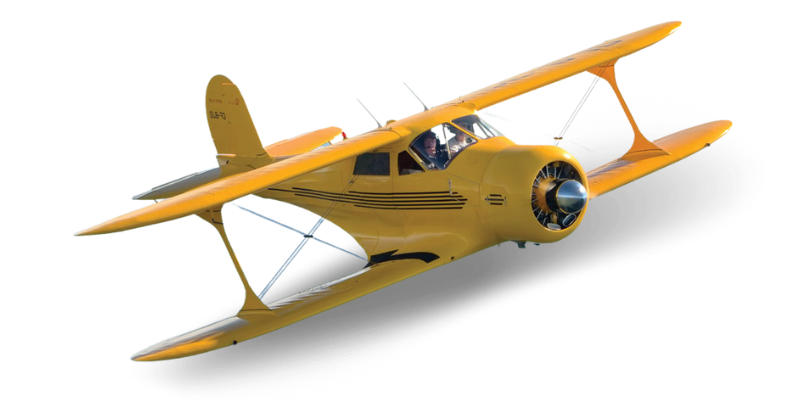The Beechcraft Staggerwing
The Beechcraft Staggerwing, the birth of private aviation.
Used by both the military and the most hurried businessmen,
this biplane, with its still modern design, features wings positioned to improve pilot visibility.
Beechcraft, through its Staggerwing model, has always been a pioneer in the aviation world.

The Beechcraft Staggerwing, its key points
The Beechcraft Staggerwing, also known as Beech 17, Beech Model 17, or even Beech D17S, first took flight on November 4, 1932.
One of the first major biplanes optimized for speed and passenger transport with its 5 seats and radial engine.
A distinctive feature of the era was that the aircraft was made of wood with retractable landing gear.
The impressive performance of the Beechcraft Staggerwing
Its Pratt & Whitney R-985 Wasp Junior radial engine provides 450 hp.
It could fly over 300 km/h with 5 seats on board and had a range of about 1000 km.
An impressive performance for the time.
Long before the invention of SAF and the massive control of pollutant emissions in airplanes, the Beechcraft Staggerwing had a relatively high fuel consumption of 80L per 100km. This high consumption provided the necessary power to reach such speeds.
Its use by the military required performance as the key feature, leading to the creation of a high-performing aircraft.
The timeless design of the Beechcraft Staggerwing
The Beechcraft Staggerwing is a 4-seat wooden biplane with an avant-garde aesthetic that still looks impressive.
The name Staggerwing of the Beech 17 comes from the unusual wing arrangement.
The upper wing is set further back than the lower wing to improve pilot visibility and reduce interference between the wings. However, this unusual design had its drawbacks.
Testimonials from the time stated that “the lower wing stalls first, causing the plane to pitch forward before bouncing on its landing gear. Stalling both wings simultaneously is necessary to maintain proper speed.”
The Beech D17S is a wooden and fabric-covered biplane with retractable landing gear, whose refined aesthetics have nurtured its legend.

The history of the Beechcraft Staggerwing
Despite the low demand in the first year, Beechcraft persisted. Prices ranged from $14,000 to $17,000 due to a depressed market for civilian aviation. A price that seems negligible today, but one must not forget the continuous inflation of the American dollar over the past centuries. The $14,000 of the time would be equivalent to approximately $300,000 today.
Only 18 examples of the aircraft were sold in the first year of production; sales resumed intermittently.
Each Model 17 Staggerwing was hand-built by a single person. The cabin of the Model 17, in leather and mohair, a woolen fiber.
The Beechcraft Staggerwing eventually succeeded in captivating due to its luxurious nature and popularity among buyers before World War II, leading to 424 recorded sales at the beginning of the Great War.
The Beechcraft Staggerwing, precursor to the private jet
With the Lear Jet in 1963, the history of private jets officially begins.
Before that, no real term existed, but a few manufacturers, including Beechcraft, already offered the idea of quickly transporting people in the private sector. The Beechcraft Staggerwing can be considered as having contributed to the arrival of the private jet as we know it today.
Its cabin optimized for comfort and performance remain essential assets for jet manufacturers.
Additionally, Beechcraft has remained a pillar in the aviation world through its “King Air” lineage, major aircraft in the private jet sector.
Its use during the war
In 1942, the U.S. Army Air Force needed an aircraft initially intended for passenger and mail transport.
To meet this demand, the federal government purchased 118 Staggerwings from private owners.
Later that year, the army also ordered 270 Beechcraft Staggerwing planes from the aircraft manufacturer.
These planes were used both in the United States and Europe as the UC-43, a derivative of the Staggerwing adapted for troop and mail transport.
After the end of the war, Beechcraft developed its civilian aircraft production capabilities with a new version of the Staggerwing, the Model G17S. Thus, 16 aircraft were built and sold at a price of $29,000.
